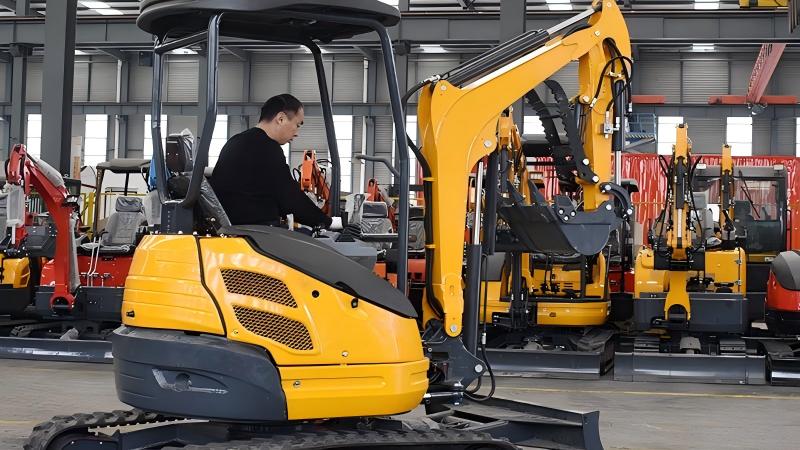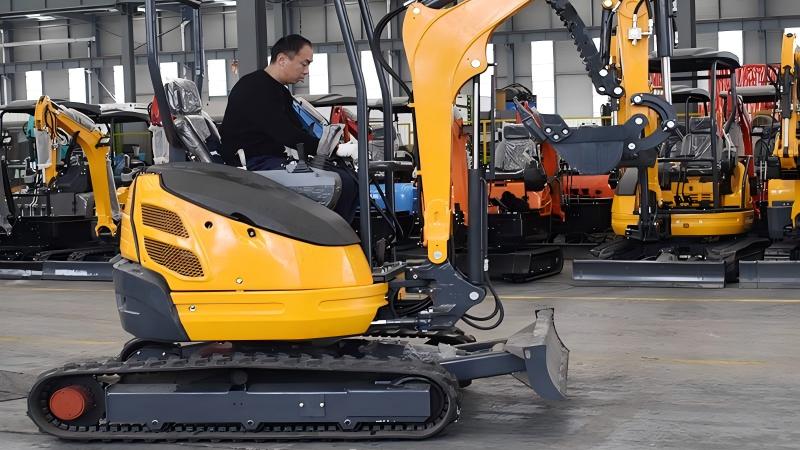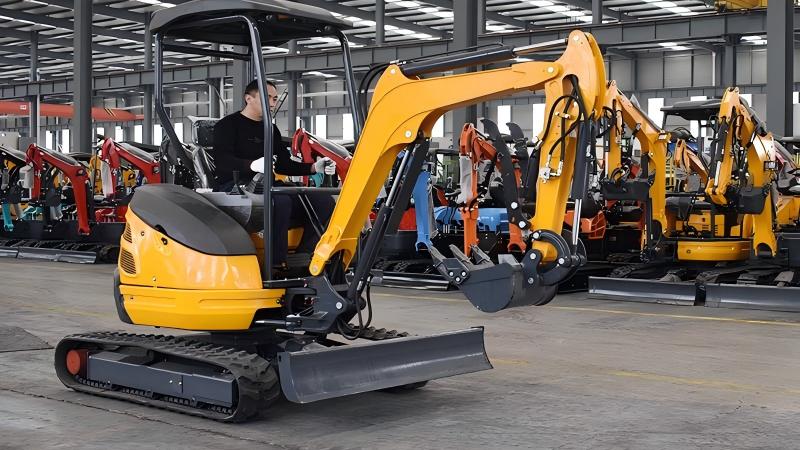Excavators are fundamental machines in construction, mining, demolition, and various other heavy industries. Known for their powerful digging, lifting, and moving capabilities, these versatile machines come in an array of types, each designed for specific tasks and environments. Understanding the different types of excavators and their unique applications is crucial for selecting the right equipment for a given job, optimizing efficiency, and ensuring safety on the worksite.
This article will explore the primary categories of excavators, detailing their characteristics, common uses, and the scenarios where they prove most effective.
Crawler Excavators (Standard Excavators)
Description: Crawler excavators are arguably the most common and recognizable type of excavator. They are mounted on a set of tracks, similar to a tank, which provides excellent stability and weight distribution over uneven or soft terrain. They feature a boom, dipper (or stick), and bucket, all mounted on a rotating cab that allows for 360-degree rotation.
Characteristics:
Stability: Tracks provide a large footprint, making them highly stable for heavy lifting and digging on slopes or soft ground.
Traction: Superior traction on difficult terrains like mud, sand, and loose soil.
Power: Generally more powerful and capable of handling heavier loads than wheeled counterparts of similar size.
Mobility: Slower travel speed and require transportation (via flatbed truck) between job sites.
Common Uses:
General Excavation: Digging trenches, foundations, and basements.
Heavy Lifting: Moving large rocks, pipes, and structural components.
Demolition: Equipped with hydraulic breakers or pulverizers for tearing down structures.
Mining and Quarrying: Extracting raw materials.
Road Construction: Earthmoving for new road beds.
Landscaping (larger projects): Major earthmoving and terrain shaping.
Wheeled Excavators
Description: Unlike crawler excavators, wheeled excavators are mounted on rubber tires. This design makes them highly mobile and capable of traveling on paved roads and hard surfaces at relatively higher speeds, eliminating the need for a separate transport vehicle for short distances.
Characteristics:
Mobility: High travel speed on paved surfaces, ideal for urban construction or sites requiring frequent movement between areas.
Versatility: Can be equipped with outriggers for enhanced stability during digging or lifting.
Surface Impact: Less damaging to paved surfaces compared to tracks.
Stability (compared to crawlers): May have reduced stability on very soft or uneven ground without outriggers.
Common Uses:
Urban Construction: Ideal for city projects where frequent movement between sites is required and road travel is common.
Road Maintenance: Pothole repair, utility work on roadsides.
Utility Installation: Digging trenches for pipes and cables in developed areas.
Material Handling: Loading and unloading trucks in yards or industrial settings.
Waste Management: Sorting and moving waste at transfer stations.
Mini Excavators (Compact Excavators)
Description: Mini excavators, also known as compact excavators or mini diggers, are smaller versions of crawler excavators, typically weighing under 6 metric tons. Their compact size allows them to operate in confined spaces where larger machines cannot.
Characteristics:
Compact Size: Can fit through narrow gates, indoors, or in tight residential areas.
Zero Tail Swing/Reduced Tail Swing: Many models feature designs where the counterweight stays within the width of the tracks, preventing damage in tight spaces.
Versatility: Capable of using a wide range of attachments
Maneuverability: Excellent for precise work.
Transportability: Easily transported on a trailer behind a pick-up truck.
Common Uses:
Landscaping: Digging ponds, planting trees, grading small areas.
Utility Trenching: Laying electrical lines, water pipes, and drainage systems in residential or commercial areas.
Plumbing and Sewer Repair: Accessing buried pipes in confined spaces.
Indoor Demolition: Tearing down interior walls or structures in buildings.
DIY Projects: Suitable for homeowners or small contractors for various tasks.
Foundation Repair: Digging around existing structures.
Long-Reach Excavators
Description: Long-reach excavators are specialized crawler or wheeled excavators equipped with an extended boom and dipper arm, allowing them to dig, dredge, or demolish structures from a safe distance. Their reach can extend significantly, often up to 60-100 feet or more.
Characteristics:
Extended Reach: Primary feature for accessing distant or deep areas.
Specialized Applications: Designed for specific tasks requiring significant reach.
Stability: Often feature additional counterweights or wider undercarriages for enhanced stability due to the extended reach.
Limited Mobility (for crawler versions): Similar to standard crawlers, movement between sites requires transportation.
Common Uses:
Dredging: Clearing sediment from rivers, lakes, and canals.
Demolition: Tearing down tall structures from a safe distance, minimizing risk to the operator.
Bridge Construction/Repair: Working on foundations or superstructures from a distance.
Slope Stabilization: Working on steep embankments or hillsides.
Excavation of Deep Basements or Pits: Reaching depths inaccessible to standard excavators.
Suction Excavators (Vacuum Excavators)
Description: Suction excavators use powerful vacuum technology to remove soil, debris, and other materials. Instead of a traditional bucket, they have a large hose that sucks up material into a containment tank. This method is non-destructive, making it ideal for working around sensitive underground utilities.
Characteristics:
Non-Destructive: Minimal risk of damaging buried pipes, cables, or other infrastructure.
Precision: Allows for highly accurate removal of material.
Safety: Reduces the risk of striking utility lines, which can cause severe accidents.
Cleanliness: Materials are contained within the tank, minimizing mess on the job site.
Common Uses:
Utility Exposure: Exposing gas lines, water pipes, electrical cables, and fiber optics.
Potholing: Creating small, precise holes to inspect underground utilities.
Trenching in Sensitive Areas: Digging trenches where conventional excavation is too risky.
Debris Removal: Cleaning up spills or removing debris from difficult-to-reach areas.
Drainage and Sewer Repair: Clearing blockages or accessing sewer lines.
Dragline Excavators
Description: Dragline excavators are massive machines primarily used in large-scale civil engineering and surface mining operations. They feature a long boom, a large digging bucket suspended from a hoist rope, and a dragline rope that pulls the bucket horizontally towards the machine.
Characteristics:
Massive Scale: Among the largest land-based machines, capable of moving enormous volumes of material.
Long Reach and Depth: Designed for high-volume excavation over vast areas.
Economic for Large Operations: Highly efficient for moving large quantities of overburden in mining.
Stationary Operation: Once set up, they operate from a fixed position, swinging the boom to cast and retrieve the bucket.
Common Uses:
Strip Mining: Removing overburden (soil and rock covering coal or other minerals).
Major Excavation Projects: Large-scale canal digging, dam construction.
Dredging Large Waterways: Maintaining navigation channels.
Clamshell Excavators
Description: Clamshell excavators are equipped with a specialized two-piece bucket that resembles a clamshell, designed to open and close. This bucket is suspended from a crane-like boom and is used for digging straight down into loose materials.
Characteristics:
Vertical Digging: Excels at digging deep, narrow shafts or pits.
Material Handling: Effective for handling loose, granular materials.
Limited Lateral Movement: Primarily designed for vertical excavation.
Common Uses:
Well Digging: Excavating deep vertical shafts.
Dredging: Removing silt and mud from underwater.
Loading Loose Materials: Efficiently loading sand, gravel, or soil from stockpiles into trucks.
Excavating in Sheet-Piled Trenches: Working within confined, shored-up areas.
Conclusion
The world of excavators is diverse, with each type engineered to meet specific demands. From the robust, all-terrain crawler excavators that form the backbone of general construction to the precise, non-destructive suction excavators safeguarding underground utilities, and the colossal draglines reshaping landscapes in mining, these machines are integral to modern infrastructure development. Understanding their unique capabilities and limitations allows industries to select the most appropriate tool, maximizing efficiency, ensuring project success, and upholding safety standards across a multitude of challenging environments.
Post time:Sep-25-2020



